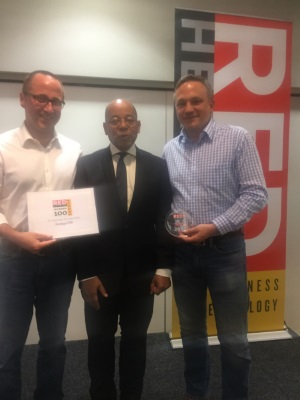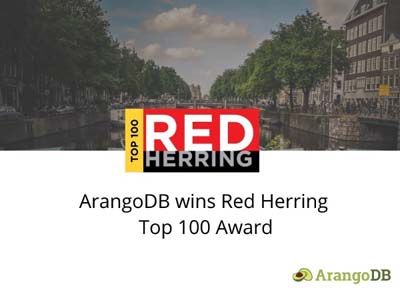ArangoDB wins Red Herring Top 100 Award
Jury selected ArangoDB out of 1.200 promising companies in Europe and confirms growing importance of native multi-model databases.
ArangoDB, the native multi-model database, announced today it was selected as a winner for
Red Herring Top 100 award for the European business region.
Red Herring Top 100 Europe enlists outstanding entrepreneurs and promising companies. Winners are selected from approximately 1,200 privately financed companies each year in the European Region. Since 1996, Red Herring has kept tabs on these up-and-comers. Red Herring’s editors were among the first to recognize that companies such as Alibaba, Facebook, Google, Kakao, Skype, SuperCell, Spotify, Twitter, and YouTube would change the way we live and work.
“It was exciting to see so many great ideas and teams from across Europe gathering in Amsterdam for Red Herring Award 2017,” said ArangoDB CEO Claudius Weinberger. “Developers, architects and CIOs around the globe have many options when it comes to databases. With ArangoDB they have a solid high performance technology for multiple purposes to simplify their tech stack. We are pleased that our vision got recognized by such a prestigious award. Now it’s about exceeding the rising expectations.”
Red Herring’s jury evaluated companies on both quantitative and qualitative criteria, such as financial performance, technological innovation and intellectual property, DNA of the founders, business model, customer footprint and addressable market. A review of the track record and standing of startups relative to their sector peers, allowing Red Herring to see past the “buzz” and making the list a valuable instrument of discovery and advocacy for the most promising new business models in Europe, complement this assessment of potential.
ArangoDB was chosen for its innovative and highly flexible multi model approach and for its massive growth on the business and community side over the past year. “In 2017, selecting the top achievers was by no means a small feat,” said Alex Vieux, publisher and CEO of Red Herring. “In fact, we had the toughest time in years because so many entrepreneurs had crossed significant milestones so early in the European tech ecosystem. We believe ArangoDB embodies the vision, drive and innovation that define a successful entrepreneurial venture. ArangoDB should be proud of its accomplishment, as the competition was very strong.”

ArangoDB Promotes Luca Olivari to President
Company creates new role to accelerate global expansion
ArangoDB, the company behind the leading native multi-model database, today announced that Luca Olivari has formally joined as President. Luca will work with the founders, board of directors and advisory council to accelerate global expansion.
“It has been a privilege to work with the founders and the rest of the team for a few months as an Advisor and witness first hand how ArangoDB helps enterprise customers to unwind complexity and improve developer productivity,” said Olivari. “As President, I will be focused on building our global customer facing functions, a productive ecosystem and a committed community.” Read more
Webinar: The native multi-model approach and its benefits for developers, architects and DevOps
Tuesday, May 16th (6PM CEST/12PM ET/ 9AM PT) – Join the webinar here.
This webinar gives a general overview of the multi-model database movement, in particular we will discuss its main advantages and technological benefits from an architect and devops perspective.
Since the first relational databases were invented the needs of companies and the technological possibilities have changed completely. Luca Olivari (recently announced President of ArangoDB) will deep dive into current trends in the database world, how native multi-model databases help companies of all sizes, and walk you through use cases where ArangoDB is beneficial. He will share decades of experience in the field and views on ever-changing needs of developers, companies and customers in the modern times. Read more
ArangoDB Selected as Finalist for Red Herring Top 100 in Europe
“ArangoDB shows great promise and therefore deserves to be among the finalists.”
ArangoDB, the native multi-model database, announced today that it has been selected as a finalist for
Red Herring Top 100 award for the European business region. The nomination underlines the great success of the company and the growing momentum behind the multi-model movement it is heralding.
“The whole team is proud to be nominated for such a prestigious award,” says Claudius Weinberger, CEO of ArangoDB. “Looking back a few years, it was hard work to win people for our multi-model approach and unique query language. Today startups and enterprises enjoy the flexibility our database provides and use it to realize their brightest ideas.” Read more
Alpha3 of ArangoDB 3.2: Support for Distributed Graph Processing
The next alpha release of the upcoming ArangoDB 3.2 is available for testing. You can download and install alpha3 here.
Moving forward
As ArangoDB 3.2 will include several new features and improvements, we realized that the release model that we currently follow has room for improvement. Going forward we will introduce milestone releases with ArangoDB 3.3. For this major release you will see a bit more alphas. You can read detailed info about the new structure model here.
Pregel computing model
In this alpha we introduce support for incremental graph processing algorithms in a single mode server as well as in the cluster. Read more
Introducing milestone release model and why is it better
When developing ArangoDB, we want to share with you new features as early as possible. For example, the pregel implementation that will become part of ArangoDB 3.2 was ready for testing weeks before the release date of the first beta release and the final release of 3.2.
Therefore we decided to create intermediate releases, called alpha releases, which contain new feature as early as they became stable. The benefits for the community and also for our developers team are: Read more
ArangoDB Online Meetup & Webinar Announced
Today we are glad to announce the start of ArangoDB Online meetup. As our international open-source community is growing with every passing day, we keep getting requests from members around the world on doing a tech meet or a short demo on ArangoDB. Quite a few members have already taken the initiative of presenting at conferences and local meetups – big “thank you” for that! Adding to that effort, it’s high time that we all moved to that one place where we can all connect and everyone has a chance to give/ participate in a talk. And what better way is there to bring us all together than meeting online? Read more
Arangochair – a tool for listening to changes in ArangoDB
The ArangoDB team gave me an opportunity to write a tutorial about arangochair. Arangochair is the first attempt to listen for changes in the database and execute actions like pushing a document to the client or execute an AQL query. Currently it is limited to single nodes.
This tutorial is loosely based on the example at baslr/arangochair-serversendevents-demo
arangochair is a Node.js module hosted on npm which make it fairly easy to install. Just run
npm install arangochair and its installed. Read more
ArangoDB 3.2 Alpha 2: Preview of Upcoming Release
The official ArangoDB 3.2 release is almost around the corner. In the meantime, you can play around and test some of the upcoming new features as they come along. The alpha2 version of the upcoming ArangoDB 3.2 is available for testing and can be downloaded here. If you already have ArangoDB installed, please remember to backup your data and run an upgrade after installing the alpha2 release. Note that this version is not suitable for production usage and is supplied only for testing purposes.
Not getting into too much detail yet – one major change in ArangoDB 3.2 is that it will contain two storage engines. The current storage engine based on memory mapped files and a new one backed by RocksDB. This alpha2 release contains some steps towards this goal, as well as independent improvements and previews of new features. Read more
Arangoexport – a tool for exporting data from ArangoDB
With the release of the initial alpha of ArangoDB version 3.2 we also include the preview of the new export tool arangoexport. Alpha2 of ArangoDB 3.2 can be downloaded here. An export functionality was initially requested by one of our community members to view an ArangoDB graph view the Cytoscape visualizer.
Arangoexport is capable of exporting a graph or certain collections of a graph to xgmml, Cytoscape’s graph format. But arangoexport is not limited to this. It can also generate JSON or JSONL data exports of arbitrary collections. Read more
Get the latest tutorials,
blog posts and news:
Thanks for subscribing! Please check your email for further instructions.
 Skip to content
Skip to content 